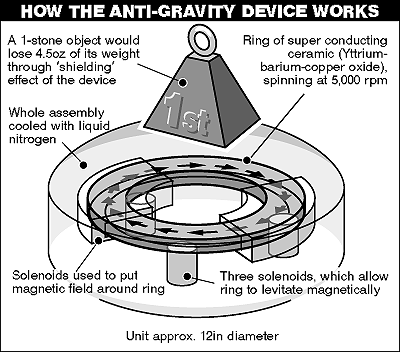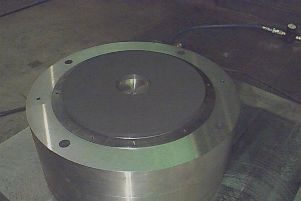

Anti Gravity Fact Or Fiction
So what's the story ?
Did physicists in Finland discover
a way to reduce gravity ?
Article in Sunday
Telegraph (UK), September 1 1996, page 3.
BREAKTHROUGH AS SCIENTISTS BEAT
GRAVITY. by Robert Matthews and Ian Sample
|
SCIENTISTS in Finland are about to reveal details of the world's
first anti-gravity device. Measuring about 12in across, the device is
said to reduce significantly the weight of anything suspended over it.
The claim -- which has been rigorously examined by scientists, and is
due to appear in a physics journal next month -- could spark a technological
revolution. By combatting gravity, the most ubiquitous force in the universe,
everything from transport to power generation could be transformed.
The Sunday Telegraph has learned that Nasa, the American space agency,
is taking the claims seriously, and is funding research into how the anti-gravity
effect could be turned into a means of flight.
The researchers at the Tampere University of Technology in Finland,
who discovered the effect, say it could form the heart of a new power
source, in which it is used to drive fluids past electricity-generating
turbines.
|
|
 |
Other uses seem limited only by
the imagination: Lifts in buildings could be replaced by devices built into
the ground. People wanting to go up would simply activate the anti-gravity device
-- making themselves weightless -- and with a gentle push ascend to the floor
they want.
Space-travel would bitcome routine,
as all the expense and danger of rocket technology is geared towards combatting
the Earth's gravitation pull. By using the devices to raise fluids against gravity,
and then conventional gravity to pull them back to earth against electricity-generating
turbines, the devices could also revolutionise power generation.
According to Dr Eugene Podkletnov,
who led the research, the discovery was accidental. It emerged during routine
work on so-called "superconductivity", the ability of some materials to lose
their electrical resistance at very low temperatures. The team was carrying
out tests on a rapidly spinning disc of superconducting ceramic suspended in
the magnetic field of three electric coils, all enclosed in a low-temperature
vessel called a cryostat.
"One of my friends came in and
he was smoking his pipe," Dr Podkletnov said. "He put some smoke over the cryostat
and we saw that the smoke was going to the ceiling all the time. It was amazing
-- we couldn't explain it." Tests showed a small drop in the weight of objects
placed over the device, as if it were shielding the object from the effects
of gravity - an effect deemed impossible by most scientists. "We thought it
might be a mistake," Dr Podkletnov said, "but we have taken every precaution."
Yet the bizarre effects persisted. The team found that even the air pressure
vertically above the device dropped slightly, with the effect detectable directly
above the device on every floor of the laboratory. In recent years, many so-called
"anti-gravity" devices have been put forward by both amateur and professional
scientists, and all have been scorned by the establishment. What makes this
latest claim different is that it has survived intense scrutiny by sceptical,
independent experts, and has been accepted for publication by the Journal of
Physics-D: Applied Physics, published by Britain's Institute of Physics.
Even so, most scientists will not
feel comfortable with the idea of anti-gravity until other teams repeat the
experiments. Some scientists suspect the anti-gravity effect is a long-sought
side-effect of Einstein's general theory of relativity, by which spinning objects
can distort gravity. Until now it was thought the effect would be far too small
to measure in the laboratory. However, Dr Ning Li, a senior research scientist
at the University of Alabama, said that the atoms inside superconductors may
magnify the effect enormously. Her research is funded by Nasa's Marshall Space
Flight centre at Huntsville, Alabama, and Whitt Brantley, the chief of Advanced
Concepts Office there, said: "We're taking a look at it, because if we don't,
we'll never know." The Finnish team is already expanding its programme, to see
if it can amplify the anti-gravity effect. In its latest experiments, the team
has measured a two per cent drop in the weight of objects suspended over the
device -and double that if one device is suspended over another. If the team
can increase the effect substantially, the commercial implications are enormous.
-- End of Article
So was this just so much hype, another
Cold Fusion. There is a small body of work that would suggest not. The effect
that Podkletnov actually seems to have discovered had already been predicted
by Dr.Li in 1989. She Predicted that if a time varying magnetic field were applied
to a superconductor, charged and deformed lattice ions within the superconductor
could absorb enormous amounts of energy via the magnetic moment effect. This
acquired energy would cause the lattice ions to spin rapidly about their equilibrium
positions and create a miniscule gravitational field. Dr. Li's calculations
showed that if these charged, rotating, lattice ions were aligned with each
other by a strong magnetic field, the resulting change in local gravity would
be measurable.
When Podkletnov made his accidental
discovery that a single-phase, dense, bulk, high T_c, superconducting, ceramic
disk spinning at 5,000 rpm can produce a 2 percent reduction in the weight of
non-conducting, non-magnetic objects placed over the spinning disc, UAH and
MSFC took note.
They set up a joint rearch team
to independently confirm the results of the Podkletnov experiment and to validate
Dr. Li's theory of gravity modification via superconduction. On March 26th,
1997, as part of this project, the joint UAH-MSFC research team produced the
largest high temperature superconducting disk ever manufactured in the USA.
This disk measures 12 inches in diameter and is 0.5 inches thick.

Said research team have a reasonably
large NASA supplied budget and have invited Podkletnov to work with them to
help them reproduce his results. As yet no other research team have been able
to veryify the experiment and Podkletnov has still to properly publish his work.
However the possibility of the effect is still being taken very seriously indeed.
Related Papers:
[Modanese] G. Modanese (1996),
On the theoretical interpration of E. Podkletnov's experiment ,
http://www.gravity.org/ont.html .
Ning Li and D. G. Torr, Phys. Rev.,
43D, 457, 1991.
Ning Li and D. G. Torr, Phys. Rev., 46B, 5489, 1992.
Ning Li and D. G. Torr, Bull. Am. Phys. Sco., 37, 948, 1992.
E. Podkletnov and R. Nieminen, Physica C, 203, 441, 1992.
D. G. Torr and Ning Li, Found. Phys. Lett., 37, 948, 1993.

